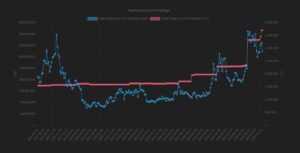Grayscale has more assets under management (AUM) than the world’ biggest gold fund. The investment giant has seen “massive” options volumes as gold takes a beating and institutions seek bitcoin exposure.
Cryptocurrencies aren’t going away. Buy Bitcoin here.
Per the latest data from the issuer, the company now manges over $60 billion — $1.7 billion more than the world leading gold fund, SPDR Gold Shares (GLD).
Grayscale GBTC flippens Gold
Grayscale’s flagship product, the Grayscale Bitcoin Trust (GBFC), holds over 646,000 BTC, worth around $41.75 billion as of November 11.
The figures add fuel the the fiery debate about bitcoin versus gold as inflationary hedges against central-bank induced runaway inflation.
With gold proving incapable of proportionally showing inflationary trends in the US and around the world, the argument for increasing Bitcoin exposure over gold has never been stronger.

One month after the first BTC futures ETF launched, volumes have become”massive”, according to Bloomberg analyst Eric Balchunas.
The licensed ProShares ETF is nearing 50% of the options volume seen in GLD and rising. Clearly, the #DropGold campaign worked wonders, with GBTC flippening GLD in terms of assets under management.
Grayscale notes “political” undertones in spot ETF approval
As Cointelegraph reported, GBTC itself is set to convert to an ETF, subject to U.S. regulatory approval, as early as summer 2022.
As noted in an earlier report, GBTC is set to convert to an ETF, which is subject to US regulatory approval that could be as early as Q2 2022.
In an interview with legacy media site CNN, the Grayscale CEO Michael Sonnenshein discussed the topic of a Bitcoin ETF approval, with the first decision due next week.
The head of the US Securities and Exchange Commission, Gary Gensler, has been relatively quiet on the potential for the watershed moment. The SEC chairman has been vocal about Bitcoin and Litecoin in the past when he taught at MIT.
Speaking to the network, Sonnenshein said:
What’s been interesting to see, however, is this is not just a regulatory issue now; this has become a political issue.
In the last week, we actually saw bipartisan support for a Bitcoin spot ETF, with Reps. Emmer and Soto submitting a letter to chairman Gensler actually calling for the approval of a Bitcoin spot ETF and really wanting to ensure there’s a level playing field for investors as they choose between what could be a futures-based product for them or a spot-based product for them.
Sonnenshein continued:
We’ve seen now the approval of the first Bitcoin futures-based ETF, which is a really important moment for our industry and something that we’re all very excited about.
But as folks have been drilling in on this, they’ve come to realize that perhaps the embedded roll costs and some of the other features in the futures products may in fact make it not as optimal for investors looking for Bitcoin exposure in their portfolios.
Futures ETFs carry additional risks as opposed to Spot-based ETFs, which raises questions as to why the SEC has approved a futures product and not a Spot-based product, which by definition protects investors more than a futures product.
This raises the question: is the SEC inadvertently putting investor’s funds at unnecessary risk?
Join the telegram channel for updates, charts, ideas and deals.
Did you like the article? Share it!


